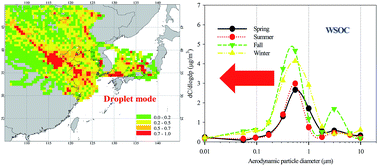Source contributions and potential source regions of size-resolved water-soluble organic carbon measured at an urban site over one year†
Abstract
In this study, 24 h size-segregated particulate matter (PM) samples were collected between September 2012 and August 2013 at an urban site in Korea to investigate seasonal mass size distributions of PM and its water-soluble components as well as to infer the possible sources of size-resolved water-soluble organic carbon (WSOC) using a positive matrix factorization (PMF) model. The potential source contribution function (PSCF) was also computed to identify the possible source regions of size-resolved WSOC. The seasonal average contribution of water-soluble organic matter to PM1.8 was in the range from 12.7 to 19.7%, but higher (21.0%) and lower contributions (8.9%) were observed during a severe haze event and an Asian dust event, respectively. The seasonal mass size distribution of WSOC had a dominant droplet mode peaking at 0.55 μm and a minor coarse mode peaking at 3.1 μm. The droplet mode WSOC was found to strongly correlate with oxalate, SO42−, NO3−, and K+, suggesting that in-cloud processes and biomass burning emissions are important sources of droplet mode WSOC. This finding was verified by the results obtained using PMF models. Secondary organic aerosols (oxalate + SO42− + NO3−) and biomass burning were the most important contributors (70.3%) to condensation mode WSOC. In the droplet mode, in-cloud processes and secondary NO3− (+biomass burning) were important sources of WSOC, contributing on average 46.4 and 25.9% to the WSOC, respectively. In the coarse mode, soil dust and secondary processes contributed 52.5 and 42.5% to the WSOC, respectively. The PMF analyses and PSCF maps of WSOC, SO42−, and K+ indicate that condensation mode WSOC was mostly influenced by the secondary organic aerosols and biomass burning from both local and long-range transported pollutants, while droplet mode WSOC was primarily the result of atmospheric processing during the long range transport of biogenic and anthropogenic pollutants from the eastern regions of China.

- This article is part of the themed collection: Natural Organic Matter


 Please wait while we load your content...
Please wait while we load your content...